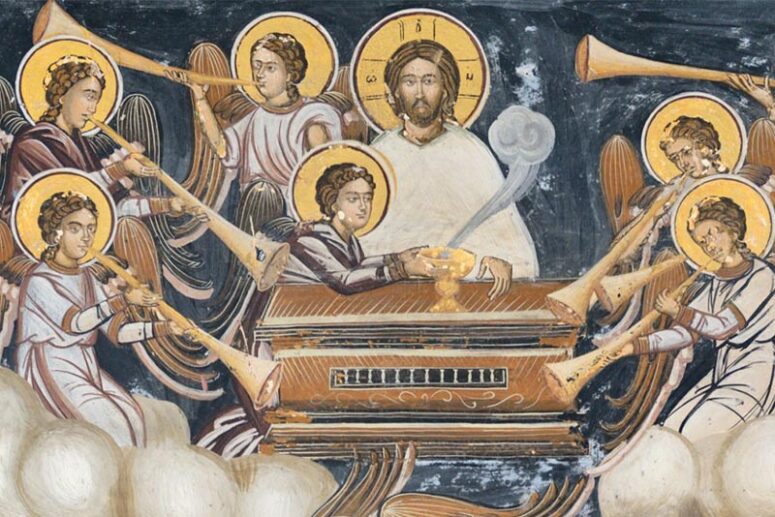
After years of regularly attending Divine Liturgy and having experienced the Communion of the Blessed Sacrament many times, many of us are well familiar with the course of the service. However, do we realise the close connection between Heaven and Earth in the moment of worship? Are we aware that all inhabitants of the Kingdom of Heaven are praying with us in the Liturgy? Delving into the Christian concept of the Heavenly Liturgy may help us discover worship in a new way. Today we invite you to embark on this exciting journey relying on Holy Scripture and apocryphal sources, as well as the liturgical images that come to life on the walls of Orthodox churches.
Definition of the Heavenly Liturgy
The Orthodox concept of the Heavenly Liturgy refers to the Heavenly powers, consisting of angels and saints, constantly serving God, offering up prayers and glorifying Him, i. e., performing a Divine Service. It may also point to the heavenly powers celebrating Liturgy together with the earthly Church. In church art, the term Heavenly Liturgy is used to denote themes in fresco painting, depicting certain moments of worship in the Heavenly Church. In this article, we will touch on these aspects.
Revelation of John the Evangelist
There are few people in Holy Scripture who, during their lifetime, were vouchsafed visions of Heavenly abodes, the Throne of God, and Heavenly worship. Among them were several Old Testament prophets (Daniel (Dan. 7:9–10), Zechariah (Zech. 1:1–6), Ezekiel (Ezek. 1:26–28) and Isaiah (Isaiah 6:1– 7)), as well as the apostles Paul (2 Cor. 12:2–4) and John the Theologian (Rev. 4–7). These visions complement one another while their similarity proves the accuracy of that which the saints described.
The most complete reflection of the Heavenly Liturgy is contained in the Revelation of John the Theologian. It captures descriptions of the Heavenly Temple and the worship there, in which one can see parallels with the earthly Church. Below are some vivid images from this God-inspired work.
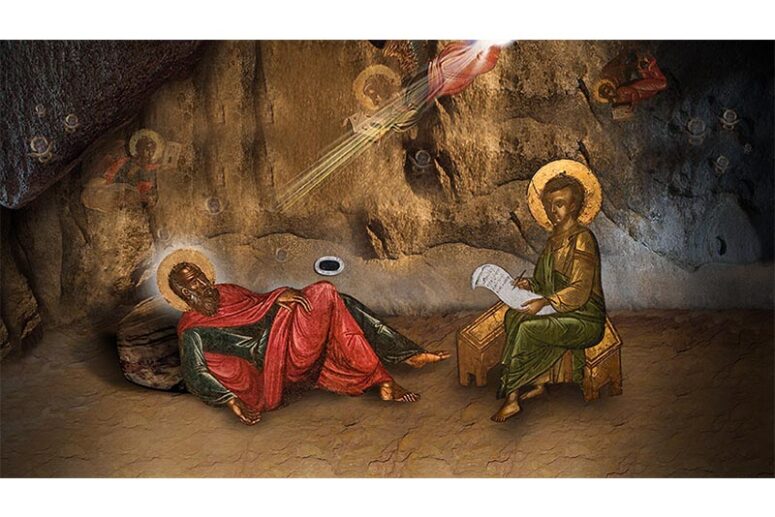
In his vision, John the Theologian entered the open doors and saw Him sitting on the throne (Rev. 4:1-2). We are guessing in these images a heavenly prototype of the Holy Doors, the altar table and the bishop’s seat – the essential elements of a church altar. The apostle also saw seven lamps of fire burning before the throne, representing the seven spirits of God (Rev. 4:5). These lights are symbolised by a menorah in the altar. In another vision, an angel with a golden censer and “a great quantity of incense” was offering up prayers of saints before the throne (Rev. 8: 3, 4). Again we see a familiar image of burning incense, “lifting up” the prayers of the faithful to the Throne of God.
Under the altar, John saw the souls of martyrs, “slaughtered for the word of God and for the testimony they had given” (Rev. 6:9). The tradition of placing the relics of martyrs under the altar table existed in the Early Church and has survived to this day.
The twenty-four elders around the throne, dressed in white clothes and wearing golden crowns on their heads (Rev. 4: 5), we understand as the 12 Old Testament patriarchs and the 12 apostles of the New Testament. In the Earthly Church, this is signified by the white inner rasons worn by the clergy during the celebration of the Liturgy. The ministry of a deacon is known to be similar to that of an angel.

In his other vision, John saw a Lamb “standing as if it had been slaughtered” (Rev. 5:6) while all who were in heaven, on earth and everywhere offered up glory, honor and thanksgiving to Him sitting on the throne and to the Lamb (Rev. 5:11-14). This is the heavenly embodiment of the Eucharistic Sacrifice, offered by priests in the form of bread and wine.
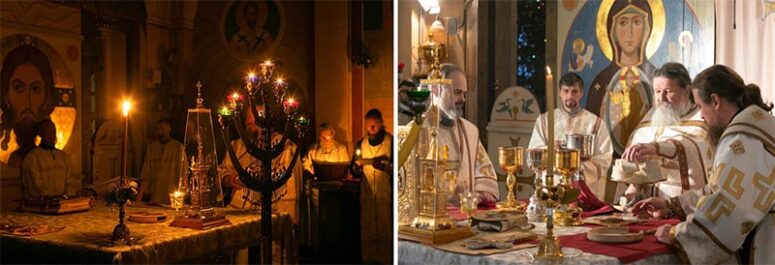
The last description from Revelation that can be attributed to the Heavenly Liturgy is the innumerable multitude from all tribes and peoples, dressed in white robes and holding palm branches in their hands, which the evangelist saw praying before the throne and the Lamb. These are all the saints and believers from the beginning of time who “have come out of the great ordeal” and “washed their robes and made them white in the blood of the Lamb” (Rev. 7:9-14). According to the thought of the renowned priest Daniel Sysoyev, this fragment shows us, believers of the earthly Church, that we should not be looking to escape difficulties in life, because “there are no unharmed in heaven” and it is impossible to be saved without enduring tribulations. We are saved by the Cross on which the Lord suffered; we “wash our robes” by receiving Baptism and repenting in Confession, and we make them white by receiving Communion.
King Anthilogus’ Account of the Holy Liturgy
Speaking of the Heavenly Liturgy, it is worth mentioning a curious historical monument – the apocryphal work, known as The Tale of the King Anthilogus on the Holy Liturgy, discovered by the Polish-Ukrainian Slavist and philologist G. Kaluzhnyatsky (1845-1914) in the archives of the St. Onuphrius Monastery in Lviv. The exact date when the Tale was written is unknown; the earliest recorded mentions of it date back to the 16th century. Below is a brief summary of it.
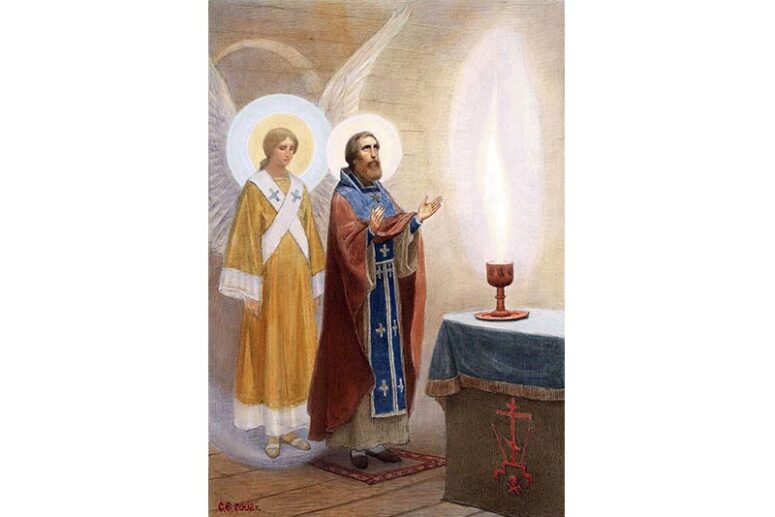
This apocryphal writing tells the story of a certain pagan king Anthilogus who decided to visit his brother in Jerusalem. When he arrived in the city, the Divine Liturgy began in the Church of the Holy Sepulcher. Wishing to see Christian worship, the king entered the church with his retinue. The Lord willed to enlighten the sinner and show him what the Liturgy looks like from Heaven, and Anthilogus saw that during the entire service the Heavenly Powers, the Archangels and the Seraphim co-celebrated with the priest, whose face was shining with unearthly light, and before whom on the holy altar was the Divine Child Himself. The blood of the Child was poured out together with water. Finally, the Holy Spirit descended on the Holy Gifts in the form of a dove and the Lord came with the 12 apostles and kissed the Holy Gifts and the priest. After the words “Take, eat […] and drink of it”, the complete sacramental change of the Holy Gifts took place. Then the angels took away the sins of the people present and burned them.
When, at the end of the liturgy, the priest presented the king with a prosphora, Anthilogus refused to take it. He expressed his indignation and bewilderment to the presbyter, wondering how he could have pierced the body of the Child. The astonished priest tried to explain to the king the Sacrament taking place at the Divine Liturgy, and said that no one had ever seen such a miracle before. The amazed Anthilogus was baptized and later converted his brother to Christianity. Together they began to preach Christ, for which they suffered to death, executed by the Saracens.
Although this work is not canonical, it does not generally contradict the teaching of the Church about the connection between the Earthly and Heavenly Liturgy, whereas in the lives of saints there are repeated descriptions of the angelic forces participating in Divine services.
Visual Representation of the Heavenly Liturgy
The teaching of the Church on the Divine Liturgy (in particular the Revelation of John the Evangelist) has been expressed by Christians in the form of images on the walls and domes of Orthodox churches as well as on church vessels. The Heavenly Liturgy is depicted by scenes featuring different episodes of worship: the procession of the Great Entrance, the Preparation of the Holy Gifts, worshipping the Lamb, the Liturgy of the Holy Fathers and, of course, the Eucharist.
According to the liturgical texts and the Council of Constantinople in 1157, the Eucharistic Sacrifice reproduces the Sacrifice of the Cross, and involves all the Persons of the Holy Trinity. Thus, the Lord acts as the true Priest at the Liturgy. He is the offering, the recipient and the Lamb being slain. This is why the imagery of the Heavenly Liturgy includes Christ the Great Hierarch in priestly vestments serving at the altar and offering Communion to the Apostles. A unique fourteenth-century historical monument from the Xeropotamou monastery on Mount Athos depicts angels performing the Great Entrance in arched frames surrounding the Mother of God on a carved artos panagiaron. At the top you can see Christ on both sides of the altar, blessing and receiving the Holy Gifts.
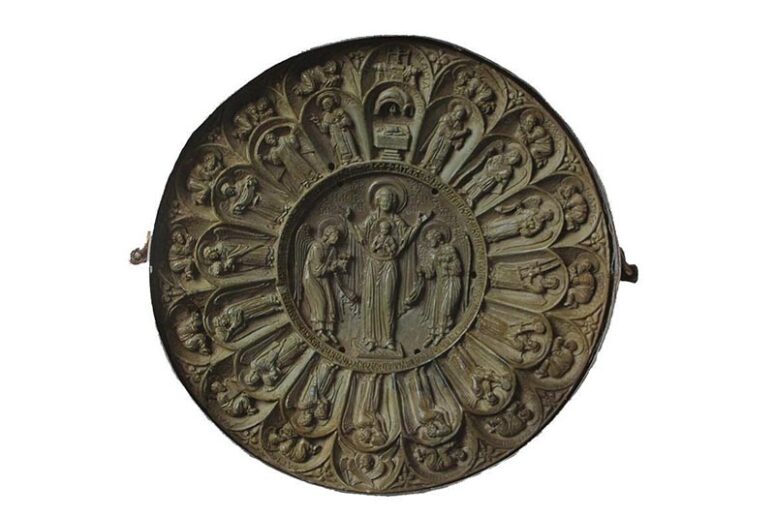
A good example of representing the Heavenly Liturgy in monumental painting is the dome of the Archangel Michael Church in Lesnovo, depicting Christ the Great Hierarch celebrating the liturgy at the altar with vessels and the Gospel, and above it – the scene of the Eucharist.
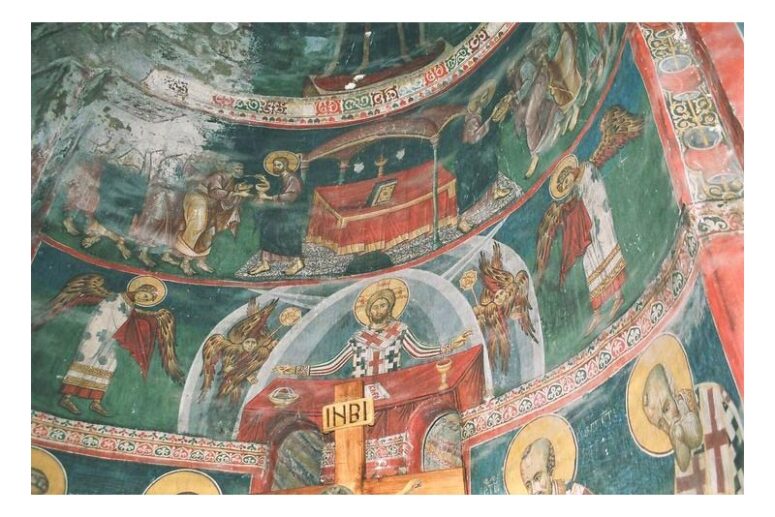
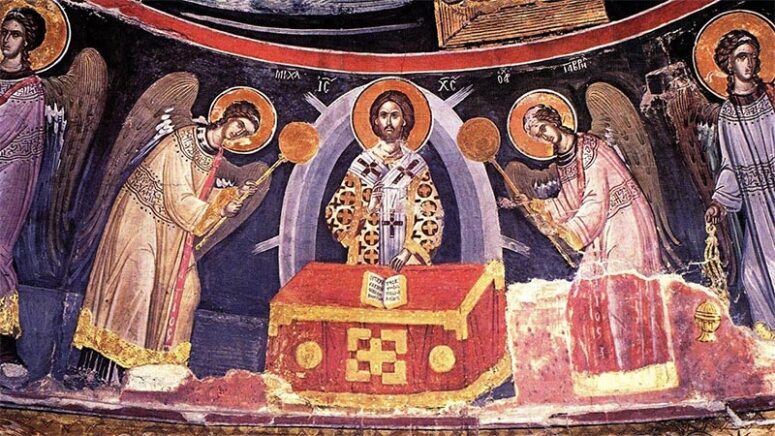
An earlier image of the Communion of the Holy Apostles can be found among the mosaics of St. Sophia Cathedral in Kiev. We can see Christ as a Priest administering the Sacrament to the apostles with angels in deacon’s vestments serving Him at the altar.
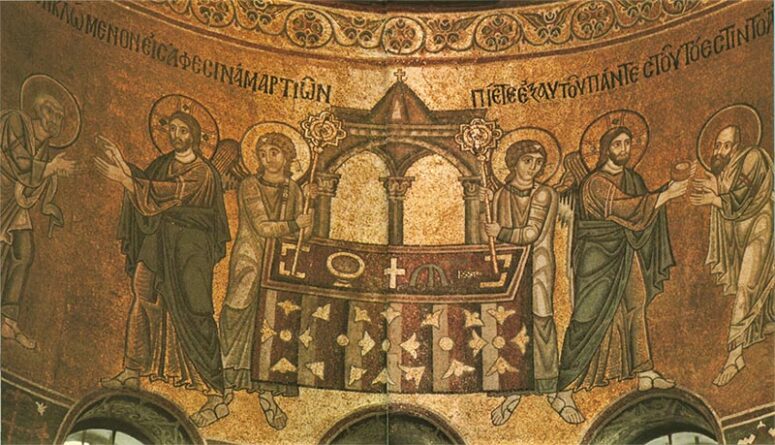
Frescoes depicting Christ giving Communion have become very widespread in the monumental painting of Orthodox churches.
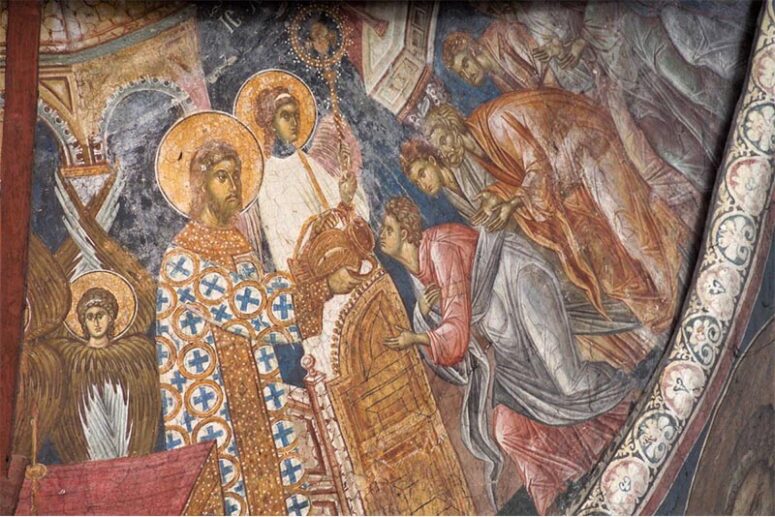
The depiction of Angels as deacons is based on the Revelation of John the Theologian. Illustrations of the Great Entrance embody the words of the Cherubic Hymn sung during the procession of priests carrying the Eucharistic Gifts from the credence to the altar, as well as the hymn “Now the Powers of Heaven…” performed at the Liturgy of the Presanctified Gifts . 14th century frescoes in the Serbian churches of Dečani and Gračanica are the most vivid ancient examples of such compositions. In Dečani, the figures of angels in diaconal and priestly vestments move in a circle towards the altar overshadowed by two seraphim. In Gračanica, angels are depicted in diaconal robes, carrying the Gifts to the altar.
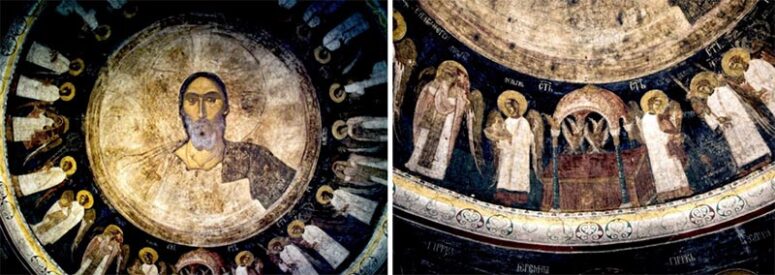
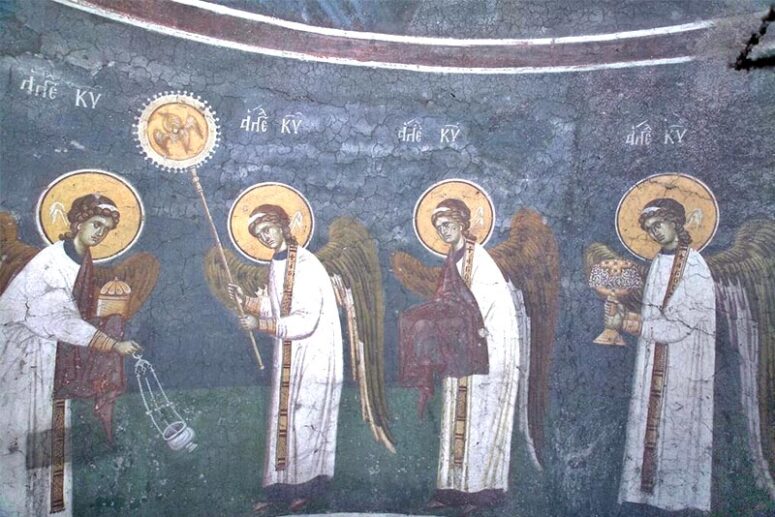
Christ is depicted as the slain Lamb in images titled “Worshipping the Sacrament” and “Offering of the Sacrifice”. Ancient (13th-14th centuries) frescoes with this imagery were preserved in the churches of the Serbian monasteries of Gračanica and Studenica. The Gračanica frescoes on the west side of the dome depict an empty altar under a canopy, from which an angel is carrying the Gifts, while on the east side there is an altar without a canopy, on which the Child covered by a veil lies. The archangels worship Christ, and a cherub overshadows Him with ripidons. On the frescoes in Studenica, the slain Lamb is surrounded by angels with ripidons.
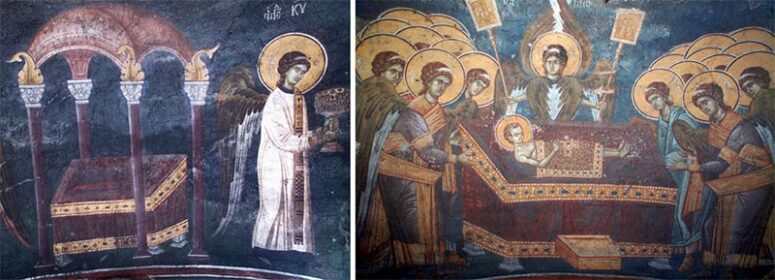
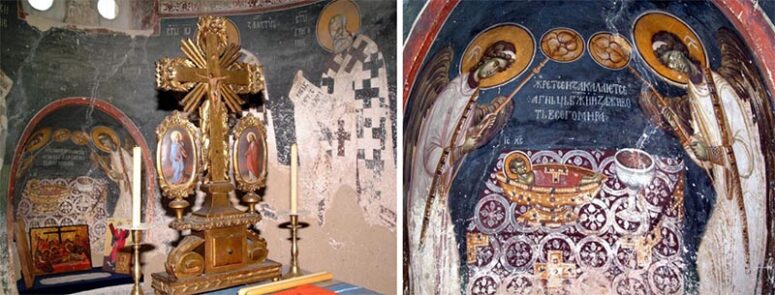
A similar theme in mural painting is the Liturgy of the Holy Fathers. For example, the compilers of the Liturgy Saints Basil the Great and John Chrysostom are often depicted with scrolls in their hands before an altar, on which lies the slain Lamb. They are accompanied by angels and cherubim overshadowing the Lamb with ripidons.
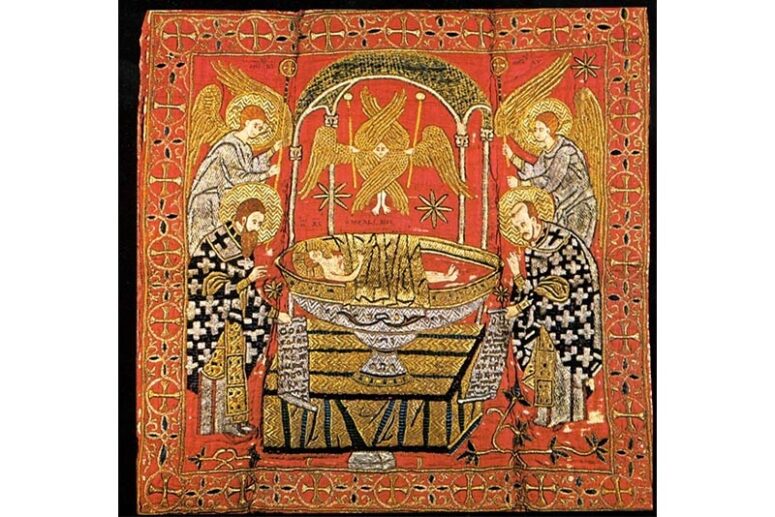

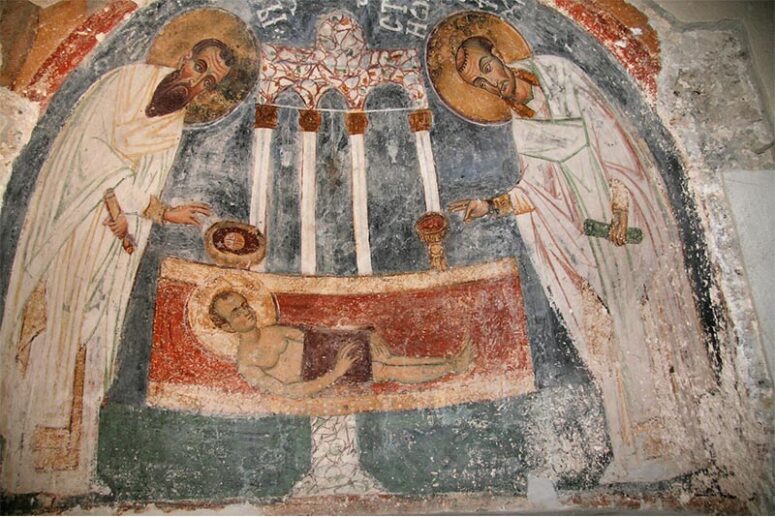
Another way of representing this theme is depicting the Holy Fathers in greater numbers, also with scrolls, but without an altar.

It is hardly possible to cover all the variations in depicting the Heavenly Liturgy, so we have considered only the most remarkable of the ancient monuments. The details in these images may differ among different peoples depending on church traditions developing over time, as well as the personal understanding of the imagery by icon painters.
Yet all depictions of the Heavenly Liturgy tend to clearly reflect the relationship of the Heavenly and Earthly Churches in the Divine Liturgy, as affirmed by the Holy Fathers. In the words of St. Maximus the Confessor, the Word of God, through the Lord’s suffering on the Cross, granted man equal dignity with the angels whereas “…in distributing the divine gifts He arranged one [common] celebration for earthly and heavenly powers, where human nature, having the same will as the heavenly powers rejoiced together with them singing glory to God”.
I would like to conclude this article by a thought from the book titled St. Theophan the Recluse and His Teaching on Salvation. The Heavenly Church is the fruit of the Earthly Church, which gives spiritual birth and perfects its children by the means granted and established by God, preparing them for eternal residence in Heavenly Jerusalem, shining with victorious glory in heaven. “The ultimate temple of God is being built in heaven while the bricks and other materials for it are prepared by the Holy Church on earth”; “the construction is not yet finished, but it will be in the end, ” St. Theophan writes.
With this in mind, let us strive to understand more deeply what is happening during Liturgy. Perhaps, remembering these revelations and parallels with the Heavenly Liturgy every time we approach the Sacraments of the Church will help us become filled with true reverence and fear of God.




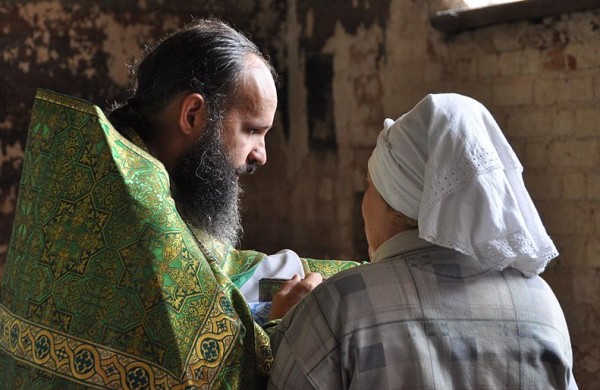
Edifying. Helpful.
Thank you. I am a catechumen, i found this article is interesting and informative.
Thank you so much for all your most interesting articles
God article, related to the heavenly liturgy you my want to check also Isaiah 6
Thank you all! We are glad that our article was useful to you!